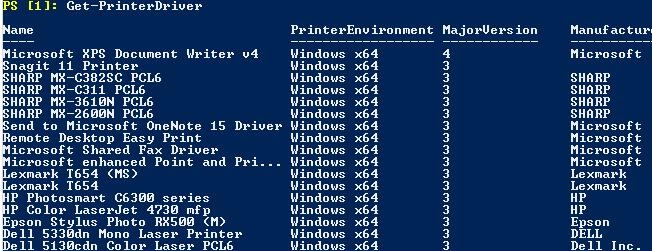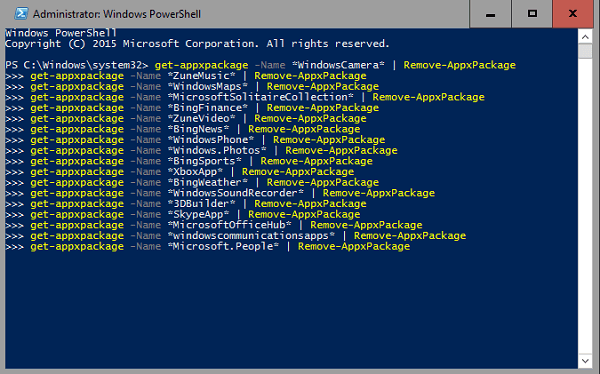- Where Can You View A List Of Installed Updates
- Get List Of Installed Updates Power Shell Tutorials
- Powershell To Show Installed Updates
- Powershell Get Installed Patches
- Uninstalled Updates
Ever wanted a simple CSV file with all the Windows updates (w/ installation status).well want no more. Run the commands below in PowerShell. PowerShell – How to get a list of all installed Windows Updates; 19 Comments. Thanks I am trying to get all updates installed and need to match from control panel.
How do I generate a list of windows patches and the date they were installed on a windows 2000 server? Ask Question 10. How do I generate a list of windows patches and the date they were installed on a windows 2000 server? An answer on Superuser for Why are “get-hotfix” and “wmic qfe list” in Powershell missing installed updates. Gathering Installed Software Using PowerShell. There's two ways to accomplish this task: the wrong way and the right way. Here's how to do both. I will perform a WMI lookup for software and then show you what happens as we are receiving data from WMI on installed software from this class. Get-WmiObject -Class Win32_Product. Listing all the patches/updates installed in Windows machine. Windows PowerShell https. I want a script to list all the patches/updates installed in my PC. I tried the below script but it does not give me complete list of patches [SQL, Visual Studio, some Office patches are not listed]. WMI may be slower but it doesn't show security updates and hotfixes. Run it from a x86 or x64 shell? Log in to Reply. To get a list of installed. Get-InstalledUpdates – List all installed updates and hotfixes. I recently got the task to inventory all installed updates and hotfixes on a bunch of cluster nodes. Yeah, I’m a noob. I don’t know how to use a function in powershell. I cannot get the TFS PowerShell Cmdlets installed. During the install, I am not prompted to install them. And, in fact, the Typical Install text states it will not install them. After installing, then going in to modify, I do not see PowerShell Cmdlets in the list of features. I am on TFS 2013 Update 4 and PowerShell 4.0.
To check if a module exists I have tried the following:
The output is:
I do get an error, but no exception is thrown, so we see Module exists in the end, although SomeModule does not exist.
Is there a good way (preferably without generating an error) to detect if a PowerShell module is installed on the system?
Peter Mortensen
10 Answers
You can use the ListAvailable option of Get-Module:
The ListAvailable option doesn't work for me. Instead this does:
Or, to be more succinct:
GaTechThomasJust revisiting this as it's something I just faced and there is some incorrect stuff in the answers (though it's mentioned in the comments).
First thing though. The original questions asks how to tell if a PowerShell module is installed. We need to talk about the word installed! You don't install PowerShell modules (not in the traditional way you install software anyway).
PowerShell modules are either available (i.e. they are on the PowerShell module path), or they are imported (they are imported into your session and you can call the functions contained). This is how to check your module path, in case you want to know where to store a module:
I'd argue that it's becoming common to use C:Program FilesWindowsPowerShellModules; more often due to it being available to all users, but if you want to lock down your modules to your own session, include them in your profile. C:Users%username%DocumentsWindowsPowerShellModules;
Alright, back to the two states.
Is the module available (using available to mean installed in the original question)?
This tells you if a module is available for import.
Is the module imported? (I'm using this as the answer for the word 'exists' in the original question).
This will either return an empty load of nothing if the module is not imported, or a one line description of the module if it is. As ever on Stack Overflow, try the commands above on your own modules.
Peter MortensenWhere Can You View A List Of Installed Updates
Get List Of Installed Updates Power Shell Tutorials
A module could be in the following states:
- imported
- available on disk (or local network)
- available in online gallery
If you just want to have the darn thing available in a PowerShell session for use, here is a function that will do that or exit out if it cannot get it done:
Peter Mortensen
Powershell To Show Installed Updates
The current version of Powershell has a Get-InstalledModule function that suits this purpose well (or at least it did in my case).
Get-InstalledModule
Description
The Get-InstalledModule cmdlet gets PowerShell modules that are installed on a computer.
The only issue with it is that it throws an exception if the module that is being requested doesn't exist, so we need to set ErrorAction appropriately to suppress that case.
Powershell Get Installed Patches
NightOwl888NightOwl888IMHO, there is difference between checking if a module is:
1) installed, or2) imported:
To check if installed:
Option 1: Using Get-Module with -ListAvailable parameter:
Option 2: Using $error object:
To check if imported:
Using Get-Module with -Name parameter (which you can omit as it is default anyway):
It should be pointed out that your cmdlet Import-Module has no terminating error, therefore the exception isnt being caught so no matter what your catch statement will never return the new statement you have written.
(https://docs.microsoft.com/en-us/powershell/module/microsoft.powershell.core/about/about_try_catch_finally?view=powershell-6
From The Above:
'A terminating error stops a statement from running. If PowerShell does not handle a terminating error in some way, PowerShell also stops running the function or script using the current pipeline. In other languages, such as C#, terminating errors are referred to as exceptions. For more information about errors, see about_Errors.'
It should be written as:
Which returns:
And if you really wanted to be thorough you should add in the other suggested cmdlets Get-Module -ListAvailable -Name and Get-Module -Name to be extra cautious, before running other functions/cmdlets. And if its installed from psgallery or elsewhere you could also run a Find-Module cmdlet to see if there is a new version available.
- First test if the module is loaded
- Then import
```
```
Uninstalled Updates
Peter MortensenComing from Linux background. I would prefer using something similar to grep, therefore I use Select-String. So even if someone is not sure of the complete module name. They can provide the initials and determine whether the module exists or not.
Get-Module -ListAvailable -All | Select-String Module_Name(can be a part of the module name)
When I use a non-default modules in my scripts I call the function below. Beside the module name you can provide a minimum version.
usage example:
Please let me known if it's usefull (or not)